 Toyota Yaris: Essential information
Toyota Yaris: Essential information
Installing towing eyelet
Type A
Remove the eyelet cover using a flathead screwdriver.
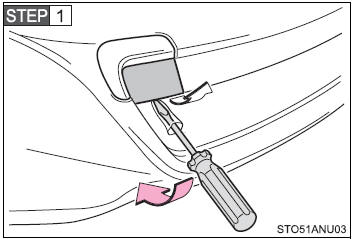
To protect the bodywork, place a rag between the screwdriver and the vehicle body as shown in the illustration.
Remove the eyelet cover using a flathead screwdriver.

To protect the bodywork, place a rag between the screwdriver and the vehicle body as shown in the illustration.
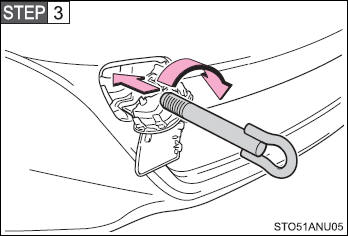
Insert the towing eyelet into the hole and tighten partially by hand.

Tighten down the towing eyelet securely using a wheel nut wrench.
Type B
Remove the eyelet cover using a flathead screwdriver.
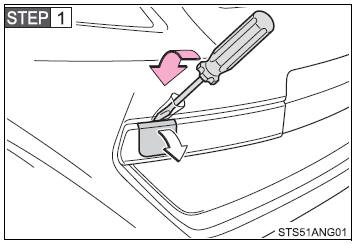
To protect the bodywork, place a rag between the screwdriver and the vehicle body as shown in the illustration.
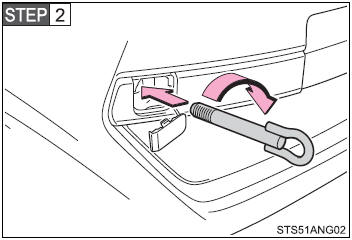
Insert the towing eyelet into the hole and tighten partially by hand.
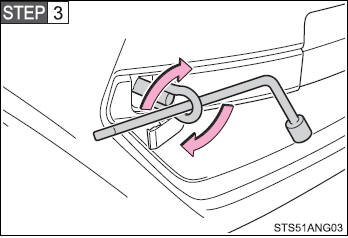
Tighten down the towing eyelet securely using a wheel nut wrench.
Towing with a sling-type truck

Do not tow with a sling type truck to prevent body damage.
Towing with a wheel-lift type truck
From the front
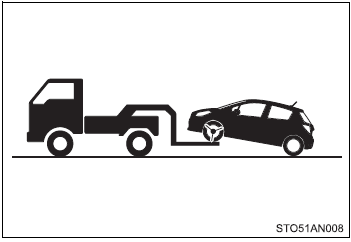
Release the parking brake.
From the rear
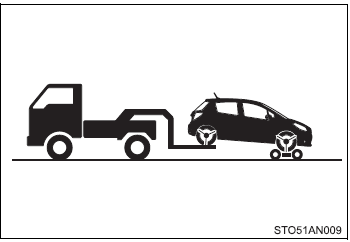
Vehicles with an automatic transmission: Use a towing dolly under the front wheels.
Vehicles with a manual transmission: We recommend using a towing dolly under the front wheels.
When not using a towing dolly, turn the engine switch to the “ACC” position and shift the shift lever to N.
Using a flatbed truck
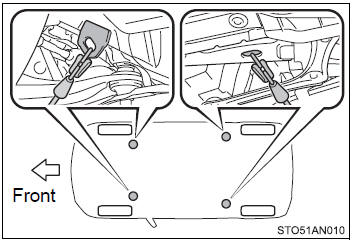
If your Toyota is transported by a flatbed truck, it should be tied down at the locations shown in the illustration.
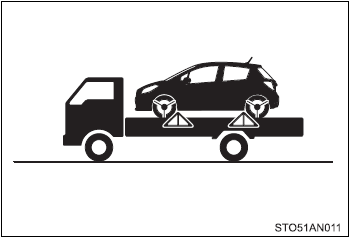
If you use chains or cables to tie down your vehicle, the angles shaded in black must be 45°. Do not overly tighten the tie downs or the vehicle may be damaged.
■Before emergency towing

Release the parking brake.

Shift the shift lever to N.

Turn the engine switch to the “ACC” (engine off) or “ON” (engine running) position.
■Emergency towing eyelet location
→P. 315
CAUTION
■Caution while towing
●Use extreme caution when towing the vehicle.
Avoid sudden starts or erratic driving maneuvers which place excessive stress on
the emergency towing eyelet and the cables or chains. Always be cautious of the
surroundings and other vehicles while towing.
●If the engine is not running, the power assist for the brakes and steering will
not function, making steering and braking more difficult.
■Installing towing eyelet to the vehicle
Make sure that towing eyelet is installed securely. If not securely installed, towing eyelet may come loose during towing. This may lead to accidents that cause serious injury or even death.
NOTICE
■To prevent causing serious damage to the transmission when towing using a wheel-lift type truck (vehicles with an automatic transmission)
Never tow this vehicle from the rear with the front wheels on the ground.
■To prevent damage to the vehicle when towing using a wheel-lift type truck (vehicles with an automatic transmission)
When raising the vehicle, ensure adequate ground clearance for towing at the opposite end of the raised vehicle. Without adequate clearance, the vehicle could be damaged while being towed.
■To prevent damage to the vehicle when towing using a wheel-lift type truck (vehicles with a manual transmission)
●Do not tow the vehicle from the rear when the engine switch is in the “LOCK”
position or the key is removed.
The steering lock mechanism is not strong enough to hold the front wheel straight.
●When raising the vehicle, ensure adequate ground clearance for towing at the opposite
end of the raised vehicle. Without adequate clearance, the vehicle could be damaged
while being towed.
■To prevent body damage when towing with a sliding-type truck
Do not tow with a sling-type truck, either from the front or rear.
 When trouble arises
When trouble arises
What to do if the vehicle needs to be towed, gets a flat tire, or is involved
in an accident. ...
 If you think something is wrong
If you think something is wrong
If you notice any of the following symptoms, your vehicle probably needs adjustment
or repair. Contact your Toyota dealer as soon as possible.
■ Visible symptoms
● Fluid leaks under th ...
See also:
Back door opening trough (ASSY): Hatchback
REPLACEMENT
With the quarter panel and body lower back panel removed.
REMOVAL
INSTALLATION
Temporarily install the new parts and measure each part of the new parts in accordance
with the bod ...
Front seats
Driver’s seat
Seat position adjustment lever
Seatback angle adjustment lever
Vertical height adjustment lever (if equipped)
Vertical height adjustment lever (if equipped) ...
Body panel anti-rust agent (wax) application areas
HINT: 1) Apply anti-rust agent (wax) around the hinges whenever adjusting the
doors and hoods.
2) Even if partially repairing a part, apply anti-rust agent (wax) over the entire
application area ...
